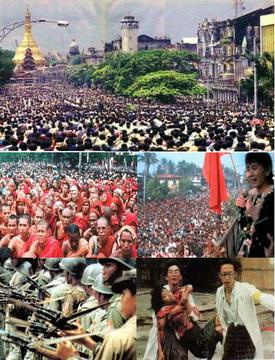| 8888 Uprising | |||
|---|---|---|---|
| Part of the Myanmar conflict | |||

| |||
| Date | 12 March – 21 September 1988 (6 months, 1 week and 2 days) | ||
| Location | Burma (nationwide) | ||
| Caused by |
| ||
| Goals | Multi-party democracy in Burma and the resignation of Ne Win | ||
| Methods | |||
| Resulted in | Military coup d'état on 18 September 1988; demonstrations suppressed by force | ||
| Concessions |
| ||
| Parties | |||
| |||
| Lead figures | |||
| Number | |||
| |||
| Casualties | |||
| Death(s) | 350 (official count) 3,000[4]–10,000[5][6] (estimates) | ||
| Injuries | Unknown | ||
| Arrested | Unknown | ||
The 8888 Uprising,[a] also known as the People Power Uprising[b] and the 1988 Uprising,[c] was a series of nationwide protests,[9] marches, and riots[10] in Burma (present-day Myanmar) that peaked in August 1988. Key events occurred on 8 August 1988 and therefore it is commonly known as the "8888 Uprising".[11] The protests began as a student movement and were organised largely by university students at the Rangoon Arts and Sciences University and the Rangoon Institute of Technology.
Since 1962, the Burma Socialist Programme Party had ruled the country as a totalitarian one-party state, headed by General Ne Win. Under the government agenda, called the Burmese Way to Socialism, which involved economic isolation and the strengthening of the military, Burma became one of the world's most impoverished countries.[12][13][14] Many firms in the formal sector of the economy were nationalised, and the government combined Soviet-style central planning with Buddhist and traditional beliefs and superstition.[14]
The 8888 uprising was started by students in Yangon (Rangoon) on 8 August 1988. Student protests spread throughout the country.[5][12] Hundreds of thousands of monks, children, university students, housewives, doctors and common people protested against the government.[15][16] The uprising ended on 18 September after a bloody military coup by the State Law and Order Restoration Council. Thousands of deaths have been attributed to the military during this uprising,[5][4][6] while authorities in Burma put the figure at around 350 people killed.[17][18]
During the crisis, Aung San Suu Kyi emerged as a national icon. When the military junta arranged an election in 1990, her party, the National League for Democracy, won 81% of the seats in the government (392 out of 492).[19] However, the military junta refused to recognise the results and continued to rule the country as the State Law and Order Restoration Council. Aung San Suu Kyi was also placed under house arrest. The State Law and Order Restoration Council would be a cosmetic change from the Burma Socialist Programme Party.[15] Suu Kyi's house arrest was lifted in 2010, when worldwide attention for her peaked again during the making of the biographical film The Lady. The Tatmadaw (Myanmar Armed Forces) again seized control of the country in the 2021 Myanmar coup d'état, which began with the imprisonment of then State Counsellor Aung San Suu Kyi. The coup has led to numerous protests and demonstrations against the military-led government. Activists have compared the current coup resistance movement to the 8888 Uprising.[20][21][22]
- ^ "Talk to Doctor from 8888 historical picture - Part 1". YouTube. Archived from the original on 8 February 2022. Retrieved 8 February 2022.
- ^ Neeraj Gautam (2009). Buddha, his life & teachings. Mahavir & Sons Publisher. ISBN 978-81-8377-247-1.[permanent dead link]
- ^ a b Cite error: The named reference
f3was invoked but never defined (see the help page). - ^ a b Fogarty, Phillipa (7 August 2008). Was Burma's 1988 uprising worth it? Archived 12 January 2009 at the Wayback Machine. BBC News.
- ^ a b c Ferrara (2003), pp. 313
- ^ a b Wintle (2007)
- ^ Yawnghwe (1995), pp. 170
- ^ Head, Jonathan (16 March 2021). "Myanmar coup: What protesters can learn from the '1988 generation'". BBC News. Archived from the original on 17 May 2021. Retrieved 17 May 2021.
- ^ Ferrara (2003), pp. 302–303
- ^ "Hunger for food, leadership sparked Burma riots". Houston Chronicle. 11 August 1988.
- ^ Tweedie, Penny. (2008). Junta oppression remembered Archived 2 May 2011 at the Wayback Machine. Reuters.
- ^ a b Burma Watcher (1989)
- ^ *Tallentire, Mark (28 September 2007). The Burma road to ruin Archived 4 March 2016 at the Wayback Machine. The Guardian.
- ^ a b Woodsome, Kate. (7 October 2007). 'Burmese Way to Socialism' Drives Country into Poverty. Voice of America.
- ^ a b Steinberg (2002)
- ^ Aung-Thwin, Maureen. (1989). Burmese Days Archived 23 February 2006 at the Wayback Machine. Foreign Affairs.
- ^ Ottawa Citizen. 24 September 1988. pg. A.16
- ^ Associated Press. Chicago Tribune. 26 September 1988.
- ^ Wintle, p. 338.
- ^ "'A dangerous time' in Myanmar: Burmese in California struggle for answers, attention". Los Angeles Times. 3 June 2021. Archived from the original on 18 September 2021. Retrieved 19 September 2021.
- ^ "[Interview] Myanmar democracy leader in S. Korea is "100% certain that this democratization movement will succeed"". english.hani.co.kr. Archived from the original on 17 September 2021. Retrieved 19 September 2021.
- ^ "Myanmar coup: What protesters can learn from the '1988 generation'". BBC News. 16 March 2021. Archived from the original on 26 September 2021. Retrieved 19 September 2021.
Cite error: There are <ref group=lower-alpha> tags or {{efn}} templates on this page, but the references will not show without a {{reflist|group=lower-alpha}} template or {{notelist}} template (see the help page).